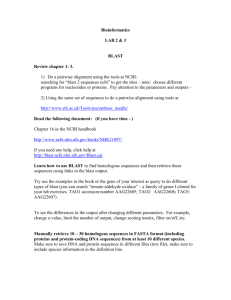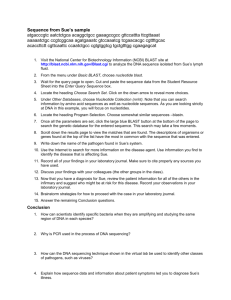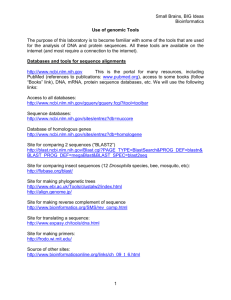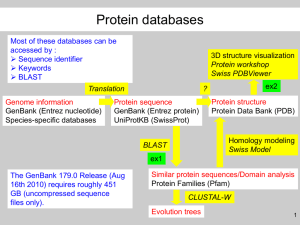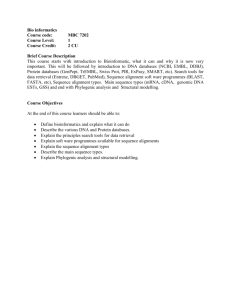GenBank: A Database of Genetic Sequence Data An Explosion of Scientific Data
advertisement
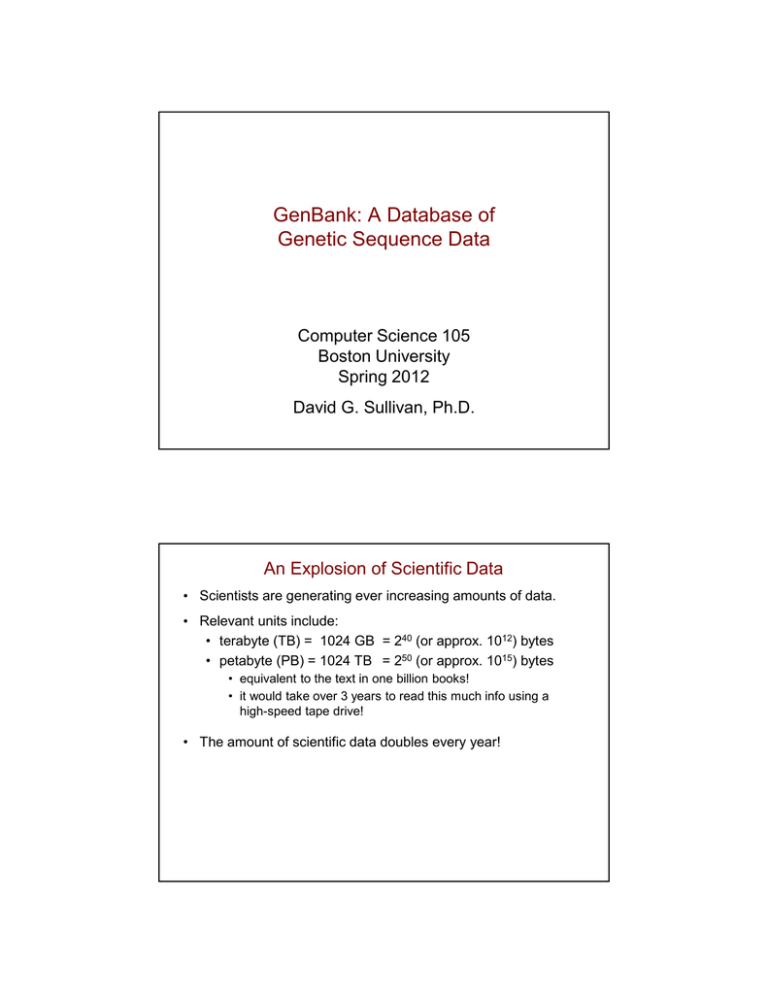
GenBank: A Database of Genetic Sequence Data Computer Science 105 Boston University Spring 2012 David G. Sullivan, Ph.D. An Explosion of Scientific Data • Scientists are generating ever increasing amounts of data. • Relevant units include: • terabyte (TB) = 1024 GB = 240 (or approx. 1012) bytes • petabyte (PB) = 1024 TB = 250 (or approx. 1015) bytes • equivalent to the text in one billion books! • it would take over 3 years to read this much info using a high-speed tape drive! • The amount of scientific data doubles every year! An Explosion of Scientific Data (cont.) • Example: GenBank database of genetic sequences 140 120 • on this graph, the data doubles every 12-14 months • as of May 2006, the doubling time was less than a year and getting shorter! Bases (billions) 100 80 60 40 20 0 Aug-97 Aug-98 Aug-99 Aug-00 Aug-01 Aug-02 Aug-03 Aug-04 Aug-05 from: NCBI Field Guide presentation (ftp://ftp.ncbi.nih.gov/pub/FieldGuide/Slides/Current/MtHolyoke.05.10.06/) An Explosion of Scientific Data (cont.) • The complexity of the data is also increasing. • need significant computing power to process it • As a result, there is an increasing trend toward scientific data centers that manage large collections of data on the behalf of scientists. • provide tools for accessing/manipulating the data GenBank • A database of genetic sequence data (DNA, RNA, etc.) • contributed by scientists; May ‘06: ~11,000 submissions/day • Managed by the National Center for Biotechnology Information (NCBI) in Bethesda, Maryland • NCBI collaborates with two other data centers: • Each repository has the same raw data (use a daily sync). • The derived data (e.g., info. on genes and proteins) is partially shared. Genetics Primer • Genome = the instructions for building an organism • recorded in DNA • form a double helix: two strands connected together in the form a “twisted ladder” • one pair of bases = one rung of the ladder • each strand contains the same info. • A always pairs with T • C always pairs with G • the strands are tightly bundled to form chromosomes image from www.yourgenome.org • DNA is built from four fundamental units called bases: • adenosine (A), guanine (G), cytosine (C), and thymidine (T) Genetics Primer (cont.) • A DNA sequence specifies the bases that appear in a given strand or substrand of DNA. • AGCTTTTCATTCTGACTGCAACGGGCAATATGTC? • up to several hundred million bases per chromosome • in humans, this adds up to a total of ~3 billion bases • Gene = a sequence of bases that is used to build a protein • example: the gene for eye color = the sequence of bases that specifies a protein that makes your eyes look blue, or brown, or ? Genomics Research • The Human Genome Project has determined the full sequence of bases in the human genome. • everyone’s genome is unique (except identical twins), but 99.9% of the bases are the same in all people • the sequenced human genome is an average of sorts • Researchers continue to add new sequence data: • from the genomes of other organisms • over 130,000 different organisms in GenBank • from the genomes of other human individuals • Researchers compare sequences from different genomes to: • identify genes • gain insight into the role of a given gene Data Storage in GenBank • The data is stored in flat text files. Example record: LOCUS DEFINITION ACCESSION VERSION KEYWORDS SOURCE ORGANISM NC_000913 4639675 bp DNA circular BCT 15-OCT-2004 Escherichia coli K12, complete genome. NC_000913 NC_000913.2 GI:49175990 . Escherichia coli K12 Escherichia coli K12 Bacteria; Proteobacteria; Gammaproteobacteria; Enterobacteriales; Enterobacteriaceae; Escherichia. 1 (bases 1 to 4639675) Blattner,F.R., Plunkett,G. III, Bloch,C.A., Perna,N.T. The complete genome sequence of Escherichia coli K-12 Science 277 (5331), 1453-1474 (1997) 97426617 9278503 REFERENCE AUTHORS TITLE JOURNAL MEDLINE PUBMED ORIGIN 1 agcttttcat tctgactgca acgggcaata tgtctctgtg tggattaaaa aaagagtgtc 61 tgatagcagc ttctgaactg gttacctgcc gtgagtaaat taaaatttta ttgacttagg 121 tcactaaata ctttaaccaa tataggcata gcgcacagac agataaaaat tacagagtac … • Stored in compressed form and available by FTP. ftp://ftp.ncbi.nih.gov Data Storage in GenBank (cont.) LOCUS DEFINITION ACCESSION VERSION … NC_000913 4639675 bp DNA circular BCT 15-OCT-2004 Escherichia coli K12, complete genome. NC_000913 NC_000913.2 GI:49175990 • Similar records are grouped together in a file. • example: the code BCT above means bacteria • the records in this file are all for bacteria • The accession number is a permanent and universally unique identifier for a particular sequence. • The version number reflects changes made to a sequence. • updating the sequence changes the version number, but it doesn’t change the accession number • Which of these numbers would you use as the primary key? Why Flat Files? • Most conventional database systems are not optimized for large strings like the ones needed for genetic sequences. • Conventional DBMSs don’t support the types of queries that are often needed. • biologists use programs (often written in Python or Perl) to perform the queries • Flat files can be viewed on any platform without specialized software. Queries I: Text Searches • Entrez Nucleotide allows you to perform a text search on the records in GenBank and other related databases. • www.ncbi.nlm.nih.gov/entrez/query.fcgi?CMD=Details&DB=nucleotide • can specify predicates based on one or more fields • examples: 3000[SLEN] (sequence length = 3000) 3000:4000[SLEN] (3000 <= sequence length <= 4000) human[orgn] (organism type = human) 3000:4000[SLEN] AND human[orgn] • what aspect of SQL does this resemble? • if you don't specify field names, Entrez performs the equivalent of a Google search on the records Example of Entrez Nucleotide Queries II: Similarity Searches • What if we want to search for sequences that "include" a particular gene or other sequence of bases? • Text search does not work well for this problem. Why? • genetic sequence data is noisy. • errors in sequencing • missing data • mutations • individual variation • common queries involve looking for similarities, rather than exact matches • problem: noise may make unrelated genes appear similar! Similarity Searches Using BLAST • BLAST is a set of online tools for performing similarity searches. • nucleotide-nucleotide BLAST (blastn) is used for similarity searches involving DNA sequences www.ncbi.nlm.nih.gov/BLAST/Blast.cgi?PAGE=Nucleotides • BLAST returns some number of hits: sequences containing subsequences whose similarity to the query is statistically significant. • the “goodness” of a match takes into account the number of insertions, deletions, and substitutions that would be needed to create a perfect match. query: TCGTCTGTT hit: AGCTTTTC TCATTCT TC TCTGAGT TCT GTCCAACGGGCAAGTC… GT aligned query: TCG-TCT TC TCT--GT TCT GTT GT Example of a BLAST Query • We've changed the database to "Nucleotide collection (nr/nt)" so that sequences from non-human organisms are included. BLAST Results • Note that both human and non-human sequences appear in the results. BLAST Results (cont.) • Each hit is accompanied by several metrics, including: • max score: measures how close the match is • higher max scores are better • E value: measures statistical significance • E = the number of hits you would expect to obtain with this max score purely by chance • lower E scores are better BLAST Results (cont.) • The results screen also displays the partial match. • Example: the query shown on the earlier slides was a 140-base sequence taken from a human sequence in the database. • it matches perfectly with other human ones • it also partially matches sequences for other organisms, including cows: Using BLAST for Cancer Research • Scientists believe that some forms of cancer are caused by viruses. • Such viruses may insert copies of their own DNA into the DNA of the infected person. • Weber et al. use BLAST to look for cancer-causing viruses. • break an infected person's DNA into many pieces • run each piece through BLAST • use the nr/nt database as before, so that non-human sequences are included Using BLAST for Cancer Research (cont.) • Which of the following sequences may be from a virus? GTATAAGTGAACCACTCAGGGTCCTGGCCGGGCACAGTGGCTCACGCCTGTAATCCCAGC ACTTTGGGAGGCCGAGGTGGGTGGATCATGAGGTCAGGAGTTCAAGACCAGCCTGGCCAA CATGGCGAAACATTGTCTCTACTAAAAGTACAAAAATTAGCCAGACGTGGTGGTGCTCAC CTGTAATCCCAGCTACTCGGGAGGCTGAGGCAGGAAAATCACTTGAACCCGGGAGGCGGA TTATTAACTGTTGGTAATCCATATTTTAGGGTTCCTGCAGGTGGTGGCAATAAGCAGGAT ATTCCTAAGGTTTCTGCATACCAATATAGAGTATTTAGGGTGCAGTTACCTGACCCAAAT AAATTTGGTTTACCTGATAATAGTATTTATAATCCTGAAACACAACGTTTAGTGTGGGCC TGTGCTGGAGTGGAAATTGGCCGTGGTCAGCCTTTAGGTGTTGGCCTTAGTGGGCATCCA ACATTTGCTTCTGACACAACTGTGTTCACTAGCAACCTCAAACAGACACCATGGTGCATC TGACTCCTGAGGAGAAGTCTGCCGTTACTGCCCTGTGGGGCAAGGTGAACGTGGATGAAG TTGGTGGTGAGGCCCTGGGCAGGCTGCTGGTGGTCTACCCTTGGACCCAGAGGTTCTTTG AGTCCTTTGGGGATCTGTCCACTCCTGATGCTGTTATGGGCAACCCTAAGGTGAAGGCTC References • Portions of these notes are based on a presentation by Griffin Weber. • Other resources: • the genomics primer at www.yourgenome.org • the NCBI Handbook (http://www.ncbi.nlm.nih.gov/books/bv.fcgi?rid=handbook) • Weber et al., "Identification of candidate infectious agents by transcript sequence filtering." Nature Genetics. 2002 Feb; 30(2):141-142


